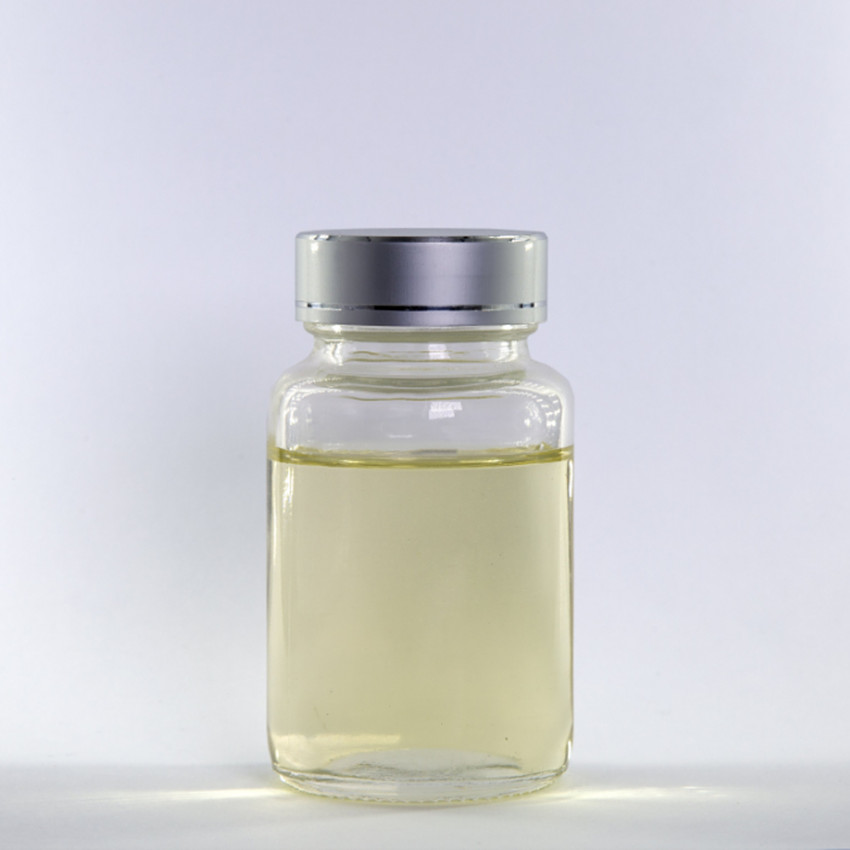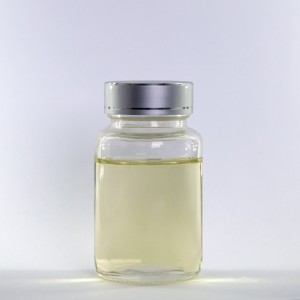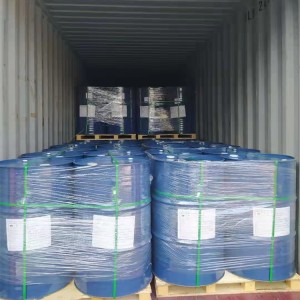ട്രൈമെഥൈൽസ്റ്റിയറിലാമോണിയം ക്ലോറൈഡ് 112-03-8
ഉൽപ്പന്ന വിശദാംശങ്ങൾ
| CAS നമ്പർ | 112-03-8 |
| തന്മാത്രാ സൂത്രവാക്യം | സി21എച്ച്46സിഎൽഎൻ |
| തന്മാത്രാ ഭാരം | 348.06 ഡെവലപ്മെന്റ് |
| EINECS നമ്പർ | 203-929-1, 203-929-1 |
| സംഭരണ \u200b\u200bവ്യവസ്ഥകൾ | നിഷ്ക്രിയ അന്തരീക്ഷം, മുറിയിലെ താപനില |
| PH മൂല്യം | 5.5-8.5 (20℃, 0.05% H2O) |
| വെള്ളത്തിൽ ലയിക്കുന്ന സ്വഭാവം | വെള്ളത്തിൽ ലയിക്കുന്നത് 1.759 mg/L @ 25°C. |
| പരമാവധി തരംഗദൈർഘ്യം | (λmax) λ: 225 nm Amax: ≤0.08λ: 260 നാനോമീറ്റർ പരമാവധി: ≤0.06 λ: 280 നാനോമീറ്റർ പരമാവധി: ≤0.04 λ: 340 നാനോമീറ്റർ പരമാവധി: ≤0.02 ബ്രൺ: 3917847 |
പര്യായങ്ങൾ
1831; TC-8; ഒക്ടാഡെസി ട്രൈമീഥൈൽ അമോണിയം ക്ലോറൈഡ്; ഒക്ടാഡെസൈൽട്രിമെഥൈലാമോണിയം ക്ലോറൈഡ്; STAC; സ്റ്റീരിയൽ ട്രൈമീഥൈൽ അമോണിയം ക്ലോറൈഡ്; സ്റ്റീരിയൽട്രിമെഥൈലാമോണിയം ക്ലോറൈഡ്; സ്റ്റീയാർട്രിമോണിയം ക്ലോറൈഡ്
വിവരണം
ഒക്ടാഡെസൈൽട്രൈമെത്തിലാമോണിയം ക്ലോറൈഡിന് കാറ്റാനിക്, നോൺയോണിക്, ആംഫോട്ടെറിക് സർഫാക്റ്റന്റുകളുമായി നല്ല പൊരുത്തമുണ്ട്, കൂടാതെ മികച്ച നുഴഞ്ഞുകയറ്റം, മൃദുവാക്കൽ, എമൽസിഫൈയിംഗ്, ആന്റിസ്റ്റാറ്റിക്, ബയോഡീഗ്രേഡബിൾ, ബാക്ടീരിയ നശിപ്പിക്കുന്ന ഗുണങ്ങളുമുണ്ട്.
അപേക്ഷ
ഒക്ടാഡെസൈൽട്രൈമെതൈലാമോണിയം ക്ലോറൈഡിന് നല്ല രാസ സ്ഥിരതയുണ്ട്, ഇത് ഹെയർ കണ്ടീഷണറുകൾ, ഫാബ്രിക് സോഫ്റ്റ്നറുകൾ, ഫൈബർ ആന്റിസ്റ്റാറ്റിക് ഏജന്റുകൾ, സിലിക്കൺ ഓയിൽ എമൽസിഫയറുകൾ, അസ്ഫാൽറ്റ് എമൽസിഫയറുകൾ, ഓർഗാനിക് ബെന്റോണൈറ്റ് മോഡിഫയറുകൾ, അണുനാശിനികൾ, പ്രോട്ടീൻ ഫ്ലോക്കുലന്റുകൾ, ബയോകെമിക്കൽ ഫാർമസ്യൂട്ടിക്കൽ വ്യവസായത്തിനുള്ള ജല സംസ്കരണ ഫ്ലോക്കുലന്റുകൾ എന്നിവയിൽ വ്യാപകമായി ഉപയോഗിക്കുന്നു.
പ്രോപ്പർട്ടികൾ
ഈ ഉൽപ്പന്നം ഇളം മഞ്ഞ കൊളോയ്ഡൽ ദ്രാവകമാണ്. ആപേക്ഷിക സാന്ദ്രത 0.884 ആണ്, HLB മൂല്യം 15.7 ആണ്, ഫ്ലാഷ് പോയിന്റ് (തുറന്ന കപ്പ്) 180℃ ആണ്, ഉപരിതല പിരിമുറുക്കം (0.1% ലായനി) 34×10-3N/m ആണ്. വെള്ളത്തിൽ ലയിക്കുന്നതിന്റെ അളവ് 20℃ ആയിരിക്കുമ്പോൾ, ലയിക്കുന്നതിന്റെ അളവ് 1% ൽ താഴെയാണ്. ആൽക്കഹോളിൽ ലയിക്കുന്നു. ഇതിന് മികച്ച സ്ഥിരത, ഉപരിതല പ്രവർത്തനം, എമൽസിഫിക്കേഷൻ, വന്ധ്യംകരണം, അണുവിമുക്തമാക്കൽ, മൃദുത്വം, ആന്റിസ്റ്റാറ്റിക് ഗുണങ്ങൾ എന്നിവയുണ്ട്.
നിയന്ത്രണങ്ങൾ മാറ്റുക
നടപടിക്രമങ്ങൾക്കനുസൃതമായാണ് മാറ്റങ്ങൾ നിയന്ത്രിക്കുന്നത്. ആഘാതം, അപകടസാധ്യത, തീവ്രത എന്നിവയെ അടിസ്ഥാനമാക്കി, മാറ്റങ്ങളെ മേജർ, മൈനർ, സൈറ്റ് എന്നിങ്ങനെ തരംതിരിക്കുന്നു. സൈറ്റ് മാറ്റങ്ങൾ ഉൽപ്പന്നത്തിന്റെ സുരക്ഷയിലും ഗുണനിലവാരത്തിലും നേരിയ സ്വാധീനം ചെലുത്തുന്നു, അതിനാൽ ഉപഭോക്താവിന് അംഗീകാരവും അറിയിപ്പും ആവശ്യമില്ല; ചെറിയ മാറ്റങ്ങൾ ഉൽപ്പന്നത്തിന്റെ സുരക്ഷയിലും ഗുണനിലവാരത്തിലും മിതമായ സ്വാധീനം ചെലുത്തുന്നു, കൂടാതെ ഉപഭോക്താവിനെ അറിയിക്കേണ്ടതുണ്ട്; പ്രധാന മാറ്റങ്ങൾ ഉൽപ്പന്നത്തിന്റെ സുരക്ഷയിലും ഗുണനിലവാരത്തിലും ഉയർന്ന സ്വാധീനം ചെലുത്തുന്നു, കൂടാതെ ഉപഭോക്താവിന്റെ അംഗീകാരം ആവശ്യമാണ്.
നടപടിക്രമം അനുസരിച്ച്, മാറ്റ നിയന്ത്രണം ആരംഭിക്കുന്നത് മാറ്റ ആപ്ലിക്കേഷനിലാണ്, അതിൽ മാറ്റ വിശദാംശങ്ങളും മാറ്റത്തിനായുള്ള യുക്തിയും വിവരിച്ചിരിക്കുന്നു. തുടർന്ന് മൂല്യനിർണ്ണയം നടത്തുന്നു, ഇത് മാറ്റ നിയന്ത്രണവുമായി ബന്ധപ്പെട്ട വകുപ്പുകളാണ് ചെയ്യുന്നത്. അതേസമയം, മാറ്റ നിയന്ത്രണം മേജർ ലെവൽ, ജനറൽ ലെവൽ, മൈനർ ലെവൽ എന്നിങ്ങനെ തരംതിരിച്ചിരിക്കുന്നു. ഉചിതമായ വിലയിരുത്തലിനും വർഗ്ഗീകരണത്തിനും ശേഷം, എല്ലാ ലെവൽ മാറ്റ നിയന്ത്രണവും QA മാനേജർ അംഗീകരിക്കണം. ആക്ഷൻ പ്ലാൻ അനുസരിച്ച് അംഗീകാരത്തിന് ശേഷം മാറ്റ നിയന്ത്രണം നടപ്പിലാക്കുന്നു. മാറ്റ നിയന്ത്രണം ഉചിതമായി നടപ്പിലാക്കിയതായി QA സ്ഥിരീകരിച്ചതിനുശേഷം മാറ്റ നിയന്ത്രണം ഒടുവിൽ അവസാനിപ്പിക്കും. ക്ലയന്റ് അറിയിപ്പ് ഉൾപ്പെട്ടിട്ടുണ്ടെങ്കിൽ, മാറ്റ നിയന്ത്രണം അംഗീകരിച്ചതിനുശേഷം ക്ലയന്റിനെ സമയബന്ധിതമായി അറിയിക്കണം.




